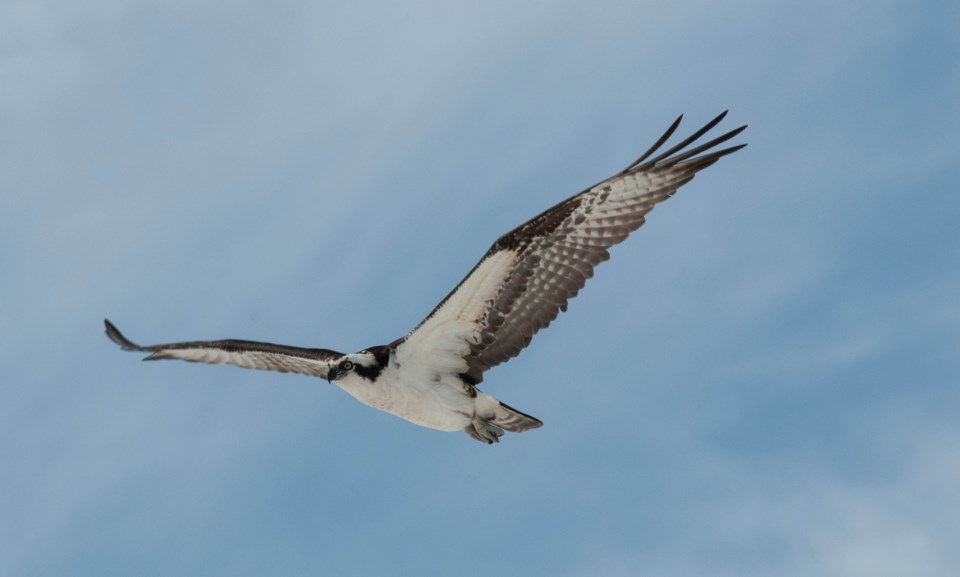“Spring has sprung, the grass has riz, I wonder where the boidies iz?” While the origin of this little jingle is arguably from Ogden Nash, it has been recited in our family for years. And, sure enough, as spring arrived, albeit in a stormy and haphazard way, so have the birds.
The act of birdwatching can be passive or intense, superfluous or in-depth. One may simply check off names (mentally or on paper) or one may opt to study bird behaviour in some detail. This column is about three observations of bird behaviours: the aggressive, the adaptive, and the normal.
Beside our home is a shallow creek, along whose banks grow grand and ancient black maples. These great trees are beginning to die from old age, and high above the once-strong limbs and trunks are now riddled with decay and are sprouting fungus shelves. Within one such sizeable branch is an excavated hole, perhaps about half the size of my fist. A week ago, chips of wood could be seen being tossed out from this hole and the occasional peek from the hairy woodpecker busy inside.
A couple of days ago, I heard a frantic commotion going on and upon investigation, found several birds down in the creek. As I approached, starlings, woodpeckers, sparrows and doves took flight in several directions. Left laying in the mud was a female hairy woodpecker, totally soaked, bloody and muddy. She had the energy left to hop up a nearby sapling and haul herself above my reach, but it was obvious that she was done for.
I wondered how she had gotten herself into such a mess and was given the answer the next day. Again, a terrible fuss was heard, this time high above near the nest hole. As I watched, the male hairy would poke his head out, and a starling, which was perched beside the entrance hole, would grab the woodpecker's head and try to pull it out! Such was the aggressive competition for nesting sites, such was the fate of the female woodpecker the day before.
The next bird observation took place along the busy paved road that connects us with the rest of the world. As I came home one evening I noted a large hawk-like bird rising from the field with prey in its talons. To cross the road, it had to fly through the telephone and hydro lines that parallel the pavement. With deft flipping and flapping, the bird managed to do so and continued on its flight across the next field.
While that was interesting enough, the shock to me was that the bird was an osprey and the prey was a sizeable fish. But this was farm land. Just as I went zooming by, I noticed that a medium-sized pond had been built within the rolling three-acre lawn of a neighbour. And within this artificial pond had been placed fish.
Imagine the osprey's line of thought as it flew by: “Hmm. A pond, in a field, with fish. Cool, I can live with that.” And it is. The question remains, can the landowner who created the pond and stocked the fish now live with the osprey who has adapted its area of hunting?
The third observation was done just outside the growing mini-metropolis I call my home town. What were once large and undulating farm fields are now filled with box-like houses, box-like stores and straight rows of paved roads. But along the borders of this 'progress' can still be found grassy strips and shrubby lots, land too small or too awkward to access to be considered 'valuable land'.
Within such a grassy slope, a red-tailed hawk spied a garter snake and dove down to capture it. (No doubt the nearby mice were thankful that something else had caught the eye of the hawk that day.) For the past several decades prior to the arrival of 'progress' this small field had been home to a wide array of creatures, from insects to wildflowers, from sparrows to groundhogs. And today a hawk did what comes naturally, it caught its daily food from within the web of life that continues to exist here.
When the hawk rose from the grasses, prey not quite firmly in hand, it landed to readjust its grip. Its perch was large, brightly coloured, square sign which read “Commercial Land For Sale.” Like a customer grabbing a deal in the closing-out sale of a long-established store, the hawk had paid a final visit to this remnant of land.
Birdwatching … more than a passive hobby – a revealing peek into the wild world of our neighbourhoods.
David Hawke is a freelance writer for OrilliaMatters.com and may be reached at [email protected].
